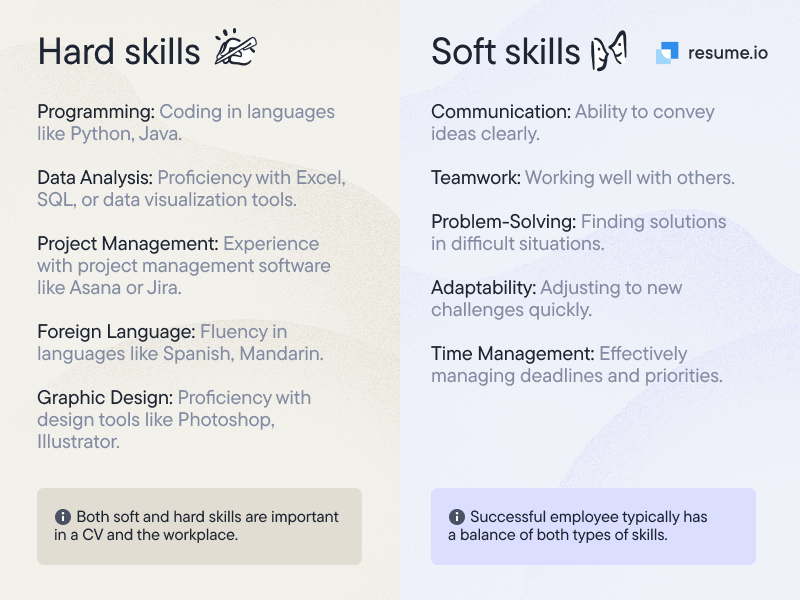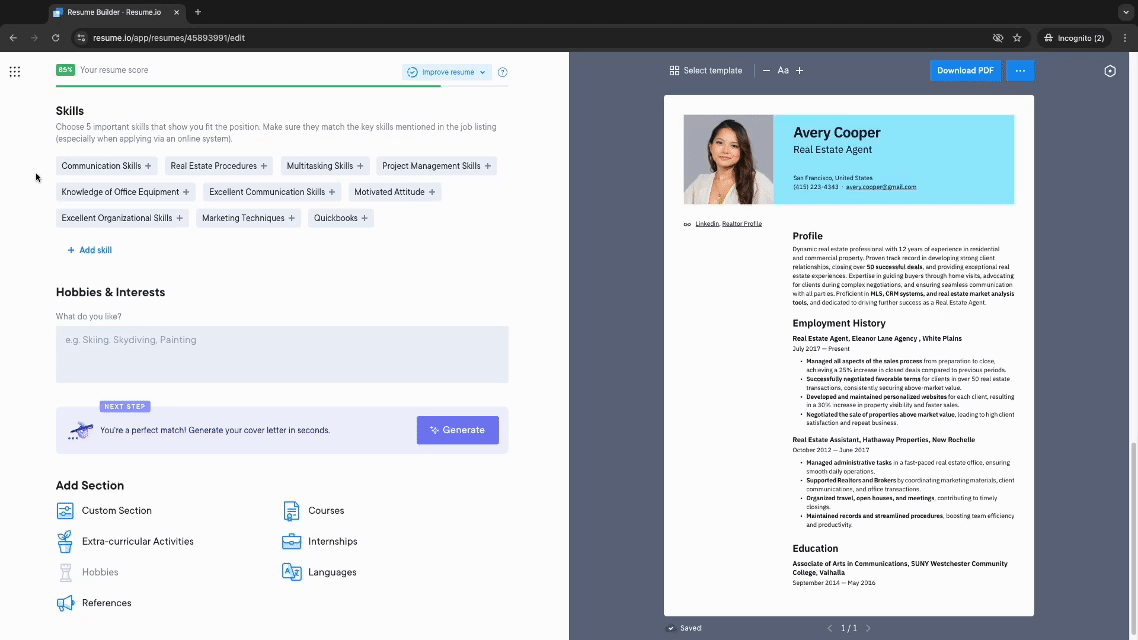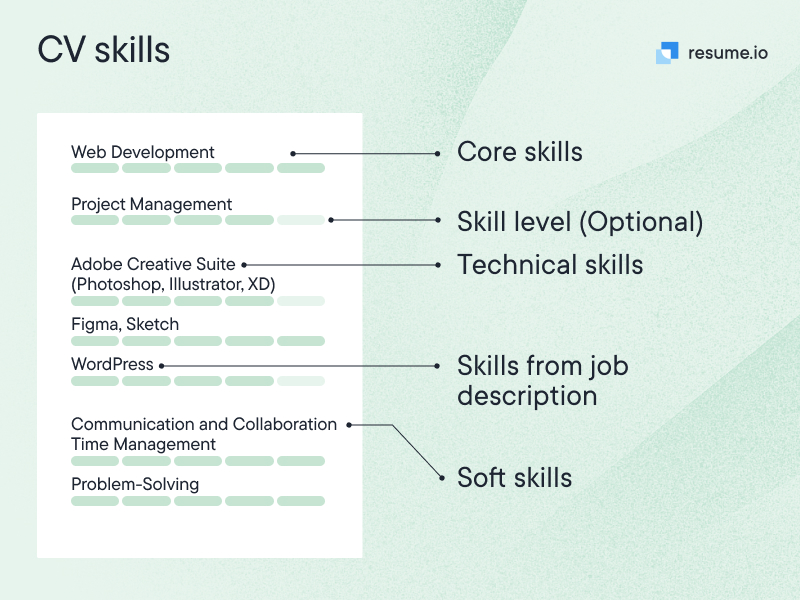Showcasing a robust skill set on your CV is a surefire way to get the hiring manager’s attention. But how can you highlight your different proficiency levels? Being specific about your expertise could set you apart from the crowd. In this guide, we take a look at what the different CV skill levels are, how to identify yours, and the best way to illustrate this to a potential employer.
Hard skills vs. soft skills
First things first, let’s talk about the different types of skills. There are two categories that you need to know about: Hard skills and soft skills. Here’s a quick breakdown of each of them:
Hard skills
Also known as technical skills, these are the competencies that apply directly to your job. These are the competencies that you need to be able to work in your particular profession. Hard skills include knowledge of certain software, regulations, and technical procedures, for example.
Soft skills
While your hard skills are important, you should not overlook soft skills. These pertain to how you work and collaborate with others. They are often called transferable skills as you can use them across a range of different industries. Examples include communication, people skills, time management, organisation, and active listening.

Get the balance right!
Make sure you include a healthy mixture of both hard and soft skills on your CV. Hiring managers are looking for well-rounded candidates when filling vacancies.
The five CV skill levels, explained
Now that you know the difference between hard and soft skills, let’s talk about the different CV skill levels. Before you start listing your competencies, you need to have a grasp on what the various levels mean in real terms. Here are the five levels that you need to know about.
1. Novice
Novice means that you have some experience with the competency, but that it is limited. You may have only recently come into contact with this skill but you’re eager to learn all about it. If you are completely new to a certain type of skill, you may use this CV skills level.
2. Beginner
Next up, beginner is what it says on the tin. You have started learning about this competency but you are not in a position where you can do it for yourself yet. However, you should note that a beginner is one step up from novice and higher on the overall CV skill levels scale.
3. Skillful
If you are competent at a certain skill, you might choose this level. Skillful applies to individuals who have a good understanding of a certain talent and can use it well. Put simply, you have moved beyond the basics when it comes to this skill and you can dig a bit deeper here.
4. Experienced
If you use this skill all of the time, you might consider yourself experienced in it. Often enough, professionals have this skill level for their core talents. This is the CV skill level to choose if you are confident in using a particular skill as part of your job, but you’re not an expert in it.
5. Expert
That brings us to the final and top CV skill level. Experts in a certain skill know all there is to know about it. They are up to date on the latest developments and always ahead of the curve. You should choose this level if you have a skill and have the knowledge to teach it to others.
How to identify your CV skill levels
Chances are, you have a range of skills that are worth boasting about. However, it can be hard to determine exactly what your CV skill levels are. You want to be as accurate and honest as you can when applying for jobs. For that reason, this part is vital to your overall success. Let’s take a look at some of the ways that you can figure out what your proficiency level is:
- Note any certificates. This is mainly applicable to hard skills. If you have undertaken specific training to learn a skill, it may be easy to decide what your level is. You can use the grade of your certificate to help you determine the right option.
- Ask your manager. Not sure where you land on the CV skill levels scale? Speak to someone about the issue. If you have regular one-on-one meetings with your manager, don’t be afraid to ask the difficult questions. Enquire about your level of proficiency in a certain area and use that as the basis for what you list on your CV.
- Consider how long you’ve been learning. Of course, time does not always equate to expertise. Still, you should consider how long you have been learning and using a certain skill. If you have been working with a competency for a matter of years, there’s a decent chance that you are either skillful or experienced in using it, for instance.
- Think about the frequency, too. How often do you use the skill in question? Does it come up now and then? Or, on the other hand, is it part of your daily role? Decide which category you fall into. The more often you use a skill, the more experienced you are likely to be in it. Keep that in mind when you’re determining your CV skill levels.
Often enough, it is simply a case of going with your gut (especially when it comes to soft skills). We recommend thinking long and hard about what you believe your CV skill levels are. Above all else, you want to give the hiring manager an accurate representation of your expertise.
Make sure your CV skills are relevant!
When deciding what skills to include on your CV, always make sure that they are relevant to the role. If you’re not sure how to do that, check the job advert. The hiring manager will have outlined some core competencies you need. See which ones you have and list them.
How to list your skill levels on a CV

Ready to get started listing your CV skill levels? Doing so could give you a competitive advantage. However, there’s a right way and a wrong way to showcase this in your next application. You need to display your expertise in a convenient and clear way. Before you start working on it, read our expert tips below:
- Find the right template. Here at Resume.io, we have a selection of CV templates that you can use. When choosing one, consider the amount of space you will need to showcase your CV skill levels properly. That way, you won’t have any design issues.
- Get some inspiration. Don’t stop there. You should also take the time to gather inspiration. Looking at our selection of 150+ CV examples and writing guides is a good place to start. Take a look at how others have displayed their CV skill levels well.
- Use a design element. Rather than simply stating your CV skill levels, make it part of the design instead. Our CV builder allows you to choose from the five previously mentioned levels when listing skills. This gives your document a professional look.
- Get the order right. Order is everything when you’re designing your CV. Make sure that you list your skills in order of level. That means starting with your best competencies at the top of the section and working your way down. This approach makes it easy for a hiring manager to see what your main value is at a glance.
- Customise your skill section. It’s vital that you tailor your CV to the vacancy and company to which you are applying. Part of this is altering your skills list. Return to the original job advert and see which competencies are written there. By weaving the ones you have throughout your CV, you can instantly boost your chances of success.

Following the above advice is a simple way to add CV skill levels to your application. This extra information will help the hiring manager determine whether you are a good fit for the job. Take the time to really think about which skills you bring to the table and your expertise level.
Key takeaways
Will you be including your CV skills levels? Throughout this guide, we have explained every part of the process in-depth. While many candidates simply list their competencies, you can set yourself apart from the crowd by using this approach. Ensure that you fully understand your levels before you start listing them on your CV. When you are ready to get started, show off your varying proficiency levels by using built-in design elements.
Take all of the hassle out of creating your next application by selecting a professional CV template. Check out our CV builder and make the whole thing a cinch today.




